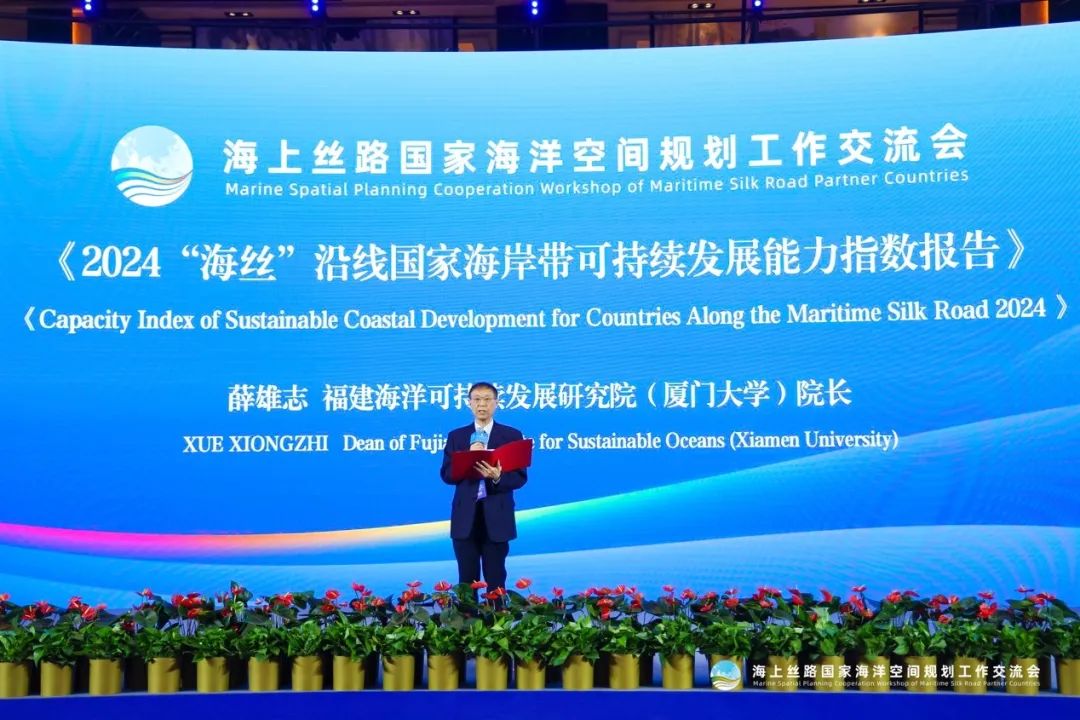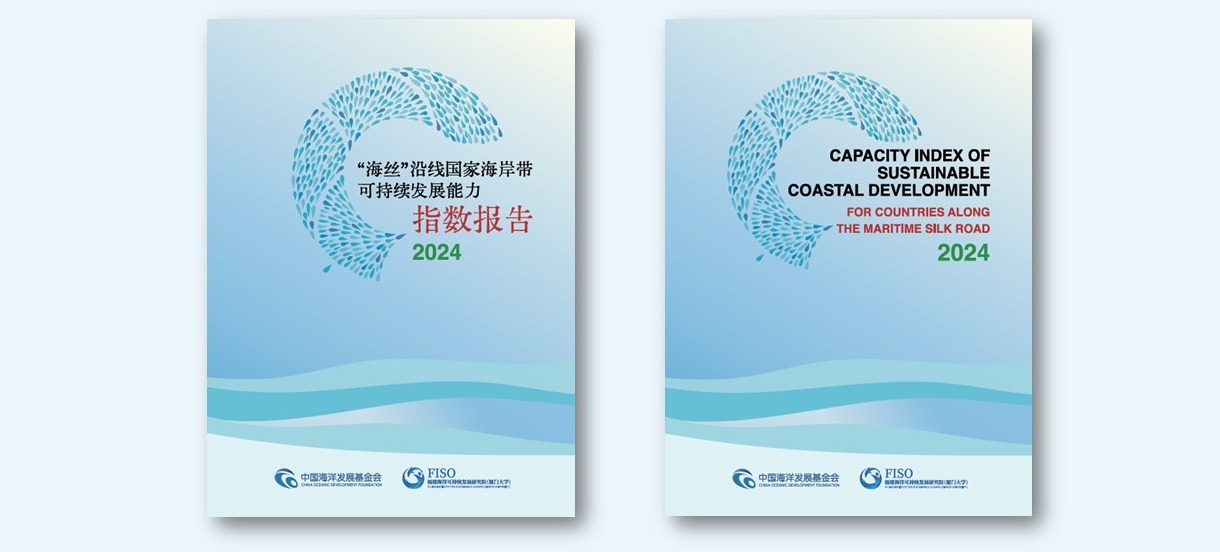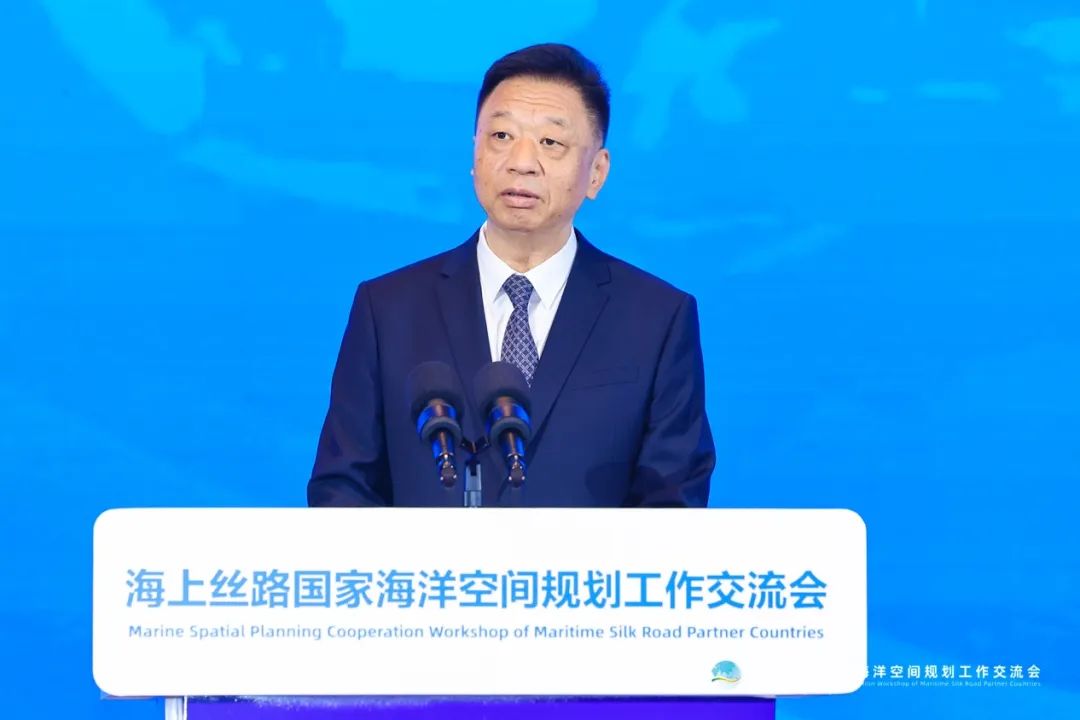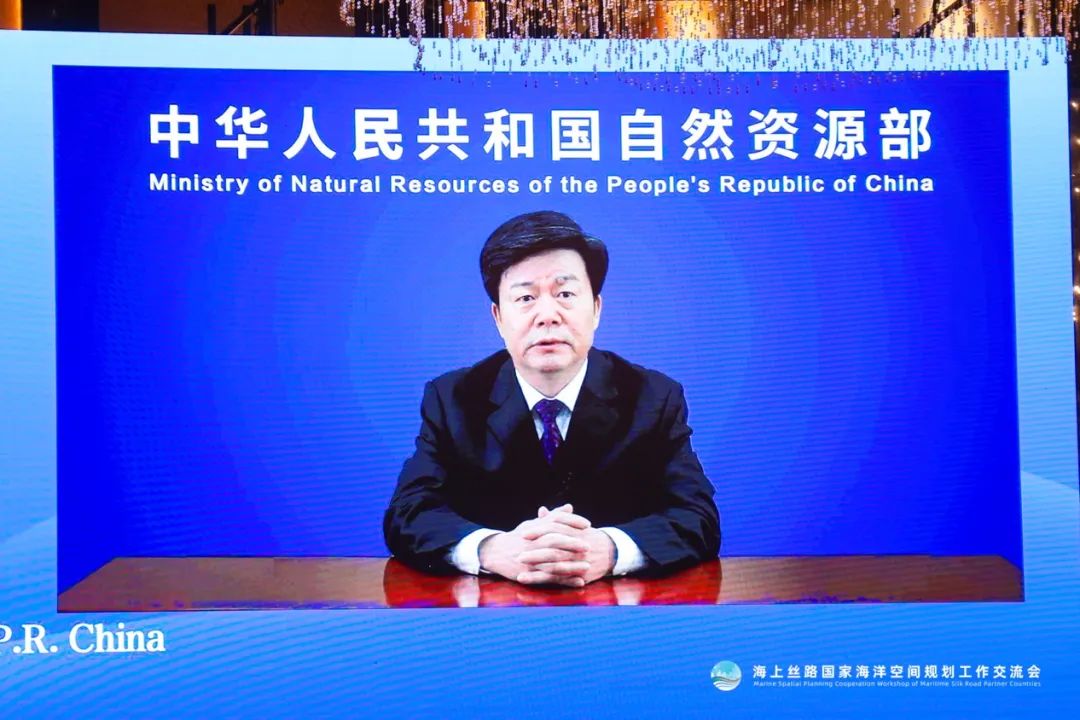2024年9月26日,在由中国海洋发展基金会主办,中国国家海洋技术中心、厦门大学、自然资源部海岛研究中心、海南省海洋厅承办的海上丝路国家海洋空间规划工作交流会开幕式上,福建海洋可持续发展研究院(厦门大学)院长薛雄志向国内外嘉宾介绍了由中国海洋发展基金会与福建海洋可持续发展研究院(厦门大学)(即福建海洋智库,简称“闽海院”)联合编制的《2024“海丝”沿线国家海岸带可持续发展能力指数报告》(中英文版,点击此处下载)。

图为薛雄志在交流会开幕式上发布指数报告
Img. Xue Xiongzhi Releases CISCD 2024

图为报告中英文封面
Img. CISCD 2024 Covers
在介绍报告诞生背景时,薛雄志院长指出,在共建“一带一路”的“海丝”沿线国家中绝大多数是涉海的发展中国家和新兴经济体,其海岸带区域普遍面临着工业化、城镇化和港口建设所带来的挑战,包括海洋生态破坏、生物多样性栖息地的侵占、环境污染、湿地减少和生态退化等问题。这些问题如果继续下去,会影响共建“一带一路”的高质量发展和海岸带资源可持续利用。为落实“一带一路”蓝色合作倡议,助力共建“一带一路”涉海国家海洋项目高质量建设和海岸带资源可持续利用,中国海洋发展基金会联合闽海院编制了《2024“海丝”沿线国家海岸带可持续发展能力指数报告》。
该报告的评价对象是与中国正式签署“一带一路”合作文件国家中的49个“海丝”沿线国家。报告根据科学性、代表性、独立性和目标相关性的指标设计原则,在保证数据来源具有可靠性、数据可得或可测并可定期更新、具有国家或地区可比性的基础上,按照大气、土地、海洋、淡水资源、生物多样性、社会发展与经济发展7个主题选取了35个指标,分析了相关“海丝”沿线国家海岸带可持续发展的能力,对海岸带区域的生态环境、资源开发、承载能力、发展潜力等做出科学评价,作为科学研究成果,供评价对象国家决策参考,以期促进全球海岸带可持续发展。
《“海丝”沿线国家海岸带可持续发展能力指数报告》自2021年起已连续四年面向全球发布,其评价范围更是扩展至49个国家。在本届海上丝路国家海洋空间规划工作交流会开幕式上,该报告受到了全国人大环境与资源保护委员会副主任王宏,自然资源部副部长、国家海洋局局长孙书贤的重视并寄予厚望,得到中国海洋发展基金会理事长吕滨和中国海洋发展基金会副理事长兼秘书长潘新春的高度肯定。同时,依托闽海院建设的海岸带可持续发展能力建设实验室,致力于为“海丝”沿线国家的海岸带可持续发展提供中国方案和中国技术,得到合作国家的充分肯定和国际同行的高度赞赏。

图为王宏在开幕式讲话
Img. Wang Hong Delivering Opening Remarks

图为孙书贤在开幕式视频讲话
Img. Sun Shuxian Delivering Video Opening Remarks

图为吕滨在开幕式讲话
Img. Lv Bin Delivering Opening Remarks

图为中国海洋发展基金会副理事长兼秘书长潘新春在开幕式讲话
Img. Pan Xinchun Delivering Opening Remarks
《“海丝”沿线国家海岸带可持续发展能力指数报告》是本次交流会中宣读的《助力共建“一带一路”海洋可持续发展合作倡议》和《支持共建“一带一路”海洋可持续发展八项行动》中均提及的重要海洋公共产品之一,同时也是海岸带可持续发展能力建设实验室的旗舰产品。该报告为“一带一路”沿海国家的海岸带自然生产力、城镇建设、岸线利用、产业布局、生态保护和防灾减灾等领域的研究提供了宝贵的参考,旨在指导和促进海岸带区域的绿色和高质量发展,推动社会、经济与生态的和谐共生,为实现联合国2030年可持续发展议程做出积极贡献。
On September 26th of 2024, at the opening ceremony of the Marine Spatial Planning Cooperation Workshop of Maritime Silk Road Partner Countries, the Capacity Index of Sustainable Coastal Development for Countries Along the Maritime Silk Road 2024 (Chinese and English versions, hereinafter referred to as the "CISCD 2024") was officially released. The CISCD 2024, jointly compiled by the China Oceanic Development Foundation (CODF) and the Fujian Institute for Sustainable Oceans of Xiamen University (FISO), was introduced to guests from home and abroad by Prof. Xue Xiongzhi, Dean of FISO. The Workshop was hosted by CODF and co-organized by the National Ocean Technology Center of Ministry of Natural Resources (MNR), P. R. China, Xiamen University, the Island Research Center of MNR, P. R. China, and the Province Oceanic Administration of Hainan.
When introducing the background of CISCD, Prof. Xue pointed out that a vast majority of Maritime Silk Road (MSR) countries involved in the joint construction of the "Belt and Road" initiative are maritime developing countries and emerging economies. Their coastal areas are challenged by industrialization, urbanization, and port construction, resulting in issues like marine ecological destruction, encroachment on biodiversity habitats, environmental pollution, wetland reduction, and ecological degradation. If these issues persist, they will affect the high-quality development of the "Belt and Road" initiative and the sustainable use of coastal resources. To implement the "Belt and Road" Blue Partnership Initiative and facilitate the high-quality construction of maritime projects and the sustainable use of coastal resources in countries involved in the "Belt and Road" initiative, CODF and FISO have therefore joint hands to compile the CISCD.
The CISCD 2024 evaluates 49 countries along the MSR that have officially signed cooperation documents with China under the "Belt and Road" initiative. Its indicator system is designed to be scientific, representative, independent, and target-relevant, ensuring that the data selected are reliable, accessible/measurable, can be updated regularly, and comparable across countries or regions. The CISCD selected 35 indicators under seven themes: atmosphere, land, ocean, freshwater, biodiversity, social development, and economic development. It analyzes the coastal sustainable development capacity of relevant MSR countries, evaluates the ecological environment, resource development, carrying capacity, and development potential of the coastal areas, and serves as a scientific research outcome to inform decision-making in the evaluated countries, ultimately aiming to promote global coastal sustainable development.
The CISCD has been released globally for four consecutive years since 2021, and its evaluation scope has now expanded to 49 countries. At the opening ceremony of this Marine Spatial Planning Cooperation Workshop of Maritime Silk Road Partner Countries, the CISCD was highly recognized by Wang Hong, Vice Chairperson of the Environmental Protection and Resources Conservation Committee of the National People's Congress, P. R. China, and Sun Shuxian, Administrator of the State Oceanic Administration and Vice Minister of MNR, P. R. China. It was also praised by Lv Bin, President of the CODF, and Pan Xinchun, Vice President and Secretary-General of the CODF. The CISCD is also a flagship product of the Sustainable Coastal Development Capacity-Building Research Lab built relying on FISO. The lab is committed to providing solutions and technologies for the sustainable development of coastal areas along the MSR, which has been acknowledged by partner countries and international counterparts.
The CISCD 2024 is one of the important marine public goods mentioned in both the "Initiative for Promoting Sustainable Ocean Development of B&R Countries" and the "Eight Actions for Promoting Sustainable Ocean Development of B&R Countries" launched at this Workshop. It provides valuable references for research in areas such as the natural productivity of coastal areas, urban construction, shoreline utilization, industrial layout, ecological protection, and disaster prevention and mitigation for "Belt and Road" coastal countries. The CISCD also aims to guide and promote green and high-quality development in coastal areas, promote coordinated development of society, economy, and ecology, and make positive contributions to achieving the United Nations 2030 Agenda for Sustainable Development.


